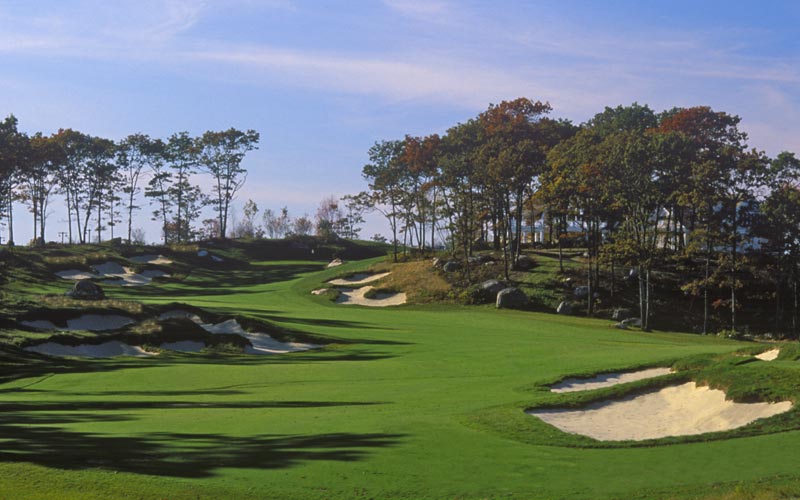Rhode Island is closely associated with the classic designs of Donald Ross. The prolific Scotsman—who maintained a summer residence in Little Compton—crafted several notable courses throughout the Ocean State. Metacomet, Misquamicut, Newport, Point Judith, Sakonnet, Triggs Memorial, Wannamoissett and several others bear his imprint.
But there’s more to golf in the nation’s smallest state than The Donald’s inverted saucer greens and grass-faced bunkers. Shelter Harbor Golf Club in Charlestown, which debuted in 2005 and was the first private club to open in Washington County in more than 100 years, can stake a claim as one of Littly Rhody’s finest courses.
Laid out by Michael Hurdzan and Dana Fry, the 7,029-yard, par-71 layout rambles across rolling, glacier-scraped terrain a mile and a half from the sea. Wetlands, mature hardwoods, rock walls, huge boulders and fescue-covered mounds define many of the holes. The fairways are generously wide, but the approach shots to the slick, undulating greens, many of them protected by deep gouged bunkers, are challenging. This is a bold course that takes full advantage of the quirky Yankee terrain.
Recently named to Golfweek’s list of the Best Modern Courses in the U.S., Shelter Harbor has received another award it cherishes just as much. The state’s Department of Environmental Management (DEM) has recognized five Rhode Island golf courses for their commitment to employing “green” environmental practices as part of a program sponsored by the Rhode Island Turf Grass Foundation. Shelter Harbor earned its way onto the list through a variety of measures.
The self-certification program is designed to reduce environmental impacts at golf courses from water usage, chemical applications, energy consumption, solid waste and air emissions. The overall goal is to help the golf industry keep Rhode Island’s land, air and water resources healthy, and at the same time cut operating expenses.

The par-5 ninth hole swings past bunkers to a hilltop green
Shelter Harbor has succeeded admirably on all counts. The club, cited by the DEM as a leader in golf course sustainability practices, has installed a state-of-the-art irrigation system and adopted and implemented a strict environmental policy. By securing a permanent easement during the planning phase, the founding members ensured that open space would be preserved and that residential development would be prohibited.
On the agronomy side, the club’s grass selections are ideal. The Velvet bentgrass greens are disease-resistant and requires less water than other bentgrass varietals. The fairways are surfaced in a mixture of fescues and bentgrass that flourish in the seaside environment. This blend has substantially reduced water, fertilizer and plant protection requirements. In sum, Shelter Harbor has demonstrated a strong commitment to conservation both on the golf course and in the clubhouse.
And what a clubhouse it is. Commanding one of the highest promontories in Rhode Island, Shelter Harbor’s 44,000-square-foot, Shingle-style edifice serves up commanding views of rolling fairways and the surrounding countryside from its octagonal gazebo. From the cupola and widow’s walk atop the clubhouse can be seen the sparkling waters of Block Island Sound and beyond the Atlantic Ocean. It’s one of the prettiest coastal views in New England.
Shortly before the golf course opened seven years ago, Dana Fry had this to say about what he called one of his firm’s most important projects.
“It (Shelter Harbor) represents a perfect blending of golf and the environment in a state where protecting the environment is a top priority,” he stated. “In our opinion, Shelter Harbor is destined to be ranked among the best golf courses in the U.S.” Mission accomplished. With a green star attached.
